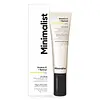What's inside
What's inside
 Key Ingredients
Key Ingredients

 Benefits
Benefits

 Concerns
Concerns

 Ingredients Side-by-side
Ingredients Side-by-side

Water
Skin ConditioningCaprylic/Capric Triglyceride
MaskingButylene Glycol
HumectantDicaprylyl Ether
EmollientSiloxanetriol Alginate
Skin ConditioningCaffeine
Skin ConditioningGlyceryl Stearate
EmollientPEG-100 Stearate
Cetearyl Alcohol
EmollientCetearyl Olivate
Sorbitan Olivate
EmulsifyingLauryl Laurate
Skin ConditioningGlycerin
HumectantC14-22 Alcohols
Emulsion StabilisingC12-20 Alkyl Glucoside
EmulsifyingStearyl Dimethicone
EmollientOctadecene
SolventAcrylates/C10-30 Alkyl Acrylate Crosspolymer
Emulsion StabilisingAllantoin
Skin ConditioningDisodium EDTA
Tocopheryl Acetate
AntioxidantSodium Hydroxide
BufferingSodium Hyaluronate
HumectantRetinol
Skin ConditioningRosa Rubiginosa Seed Oil
EmollientScutellaria Baicalensis Root Extract
AstringentPaeonia Suffruticosa Root Extract
Skin ProtectingSaxifraga Sarmentosa Extract
Skin ConditioningAcetyl Tyrosine
Skin ConditioningArbutin
AntioxidantGlutathione
Aminopropyl Ascorbyl Phosphate
AntioxidantSimmondsia Chinensis Seed Oil
EmollientMethylsilanol Mannuronate
Skin ConditioningOlea Europaea Fruit Oil
MaskingPunica Granatum Seed Oil
EmollientArgania Spinosa Kernel Oil
EmollientCoffea Arabica Seed Extract
MaskingBenzyl Alcohol
PerfumingEthylhexylglycerin
Skin ConditioningTocopherol
AntioxidantBHT
AntioxidantWater, Caprylic/Capric Triglyceride, Butylene Glycol, Dicaprylyl Ether, Siloxanetriol Alginate, Caffeine, Glyceryl Stearate, PEG-100 Stearate, Cetearyl Alcohol, Cetearyl Olivate, Sorbitan Olivate, Lauryl Laurate, Glycerin, C14-22 Alcohols, C12-20 Alkyl Glucoside, Stearyl Dimethicone, Octadecene, Acrylates/C10-30 Alkyl Acrylate Crosspolymer, Allantoin, Disodium EDTA, Tocopheryl Acetate, Sodium Hydroxide, Sodium Hyaluronate, Retinol, Rosa Rubiginosa Seed Oil, Scutellaria Baicalensis Root Extract, Paeonia Suffruticosa Root Extract, Saxifraga Sarmentosa Extract, Acetyl Tyrosine, Arbutin, Glutathione, Aminopropyl Ascorbyl Phosphate, Simmondsia Chinensis Seed Oil, Methylsilanol Mannuronate, Olea Europaea Fruit Oil, Punica Granatum Seed Oil, Argania Spinosa Kernel Oil, Coffea Arabica Seed Extract, Benzyl Alcohol, Ethylhexylglycerin, Tocopherol, BHT
Water
Skin ConditioningGlycerin
HumectantNiacinamide
SmoothingDimethicone
EmollientPropanediol
SolventCaffeine
Skin ConditioningDicaprylyl Carbonate
EmollientBrassica Glycerides
EmollientDiisopropyl Sebacate
EmollientMaltodextrin
AbsorbentGlyceryl Glucoside
HumectantBehenyl Alcohol
EmollientButylene Glycol
HumectantPhytonadione Epoxide
AstringentPrunus Amygdalus Dulcis Oil
Skin ConditioningHydroxyethylcellulose
Emulsion StabilisingPentylene Glycol
Skin ConditioningHydrolyzed Sodium Hyaluronate
Skin ConditioningZerumbone
Skin ConditioningN-Hydroxysuccinimide
Skin ConditioningDipeptide-2
Skin ConditioningSteareth-20
CleansingChrysin
Skin ConditioningPalmitoyl Tetrapeptide-7
Skin ConditioningXanthan Gum
EmulsifyingRetinal
Skin ConditioningSodium Hyaluronate
HumectantHesperidin Methyl Chalcone
AntioxidantPhenoxyethanol
PreservativeCarbomer
Emulsion StabilisingPalmitoyl Tripeptide-1
Skin ConditioningEthylhexylglycerin
Skin ConditioningCitric Acid
BufferingTrisodium Ethylenediamine Disuccinate
Water, Glycerin, Niacinamide, Dimethicone, Propanediol, Caffeine, Dicaprylyl Carbonate, Brassica Glycerides, Diisopropyl Sebacate, Maltodextrin, Glyceryl Glucoside, Behenyl Alcohol, Butylene Glycol, Phytonadione Epoxide, Prunus Amygdalus Dulcis Oil, Hydroxyethylcellulose, Pentylene Glycol, Hydrolyzed Sodium Hyaluronate, Zerumbone, N-Hydroxysuccinimide, Dipeptide-2, Steareth-20, Chrysin, Palmitoyl Tetrapeptide-7, Xanthan Gum, Retinal, Sodium Hyaluronate, Hesperidin Methyl Chalcone, Phenoxyethanol, Carbomer, Palmitoyl Tripeptide-1, Ethylhexylglycerin, Citric Acid, Trisodium Ethylenediamine Disuccinate
Ingredients Explained
These ingredients are found in both products.
Ingredients higher up in an ingredient list are typically present in a larger amount.
Butylene Glycol (or BG) is used within cosmetic products for a few different reasons:
Overall, Butylene Glycol is a safe and well-rounded ingredient that works well with other ingredients.
Though this ingredient works well with most skin types, some people with sensitive skin may experience a reaction such as allergic rashes, closed comedones, or itchiness.
Learn more about Butylene GlycolCaffeine is most associated with coffee, tea, and cacao. In skincare, it helps with calming inflammation and is rich in antioxidants.
While caffeine is used to treat cellulite and and dark circles, further studies are needed to prove this. It has been believed to help with these skin conditions due to its ability to dilate blood vessels and increase blood flow.
Some studies are looking into caffeine's ability to protect against UV rays.
Learn more about CaffeineEthylhexylglycerin (we can't pronounce this either) is commonly used as a preservative and skin softener. It is derived from glyceryl.
You might see Ethylhexylglycerin often paired with other preservatives such as phenoxyethanol. Ethylhexylglycerin has been found to increase the effectiveness of these other preservatives.
Glycerin is already naturally found in your skin. It helps moisturize and protect your skin.
A study from 2016 found glycerin to be more effective as a humectant than AHAs and hyaluronic acid.
As a humectant, it helps the skin stay hydrated by pulling moisture to your skin. The low molecular weight of glycerin allows it to pull moisture into the deeper layers of your skin.
Hydrated skin improves your skin barrier; Your skin barrier helps protect against irritants and bacteria.
Glycerin has also been found to have antimicrobial and antiviral properties. Due to these properties, glycerin is often used in wound and burn treatments.
In cosmetics, glycerin is usually derived from plants such as soybean or palm. However, it can also be sourced from animals, such as tallow or animal fat.
This ingredient is organic, colorless, odorless, and non-toxic.
Glycerin is the name for this ingredient in American English. British English uses Glycerol/Glycerine.
Learn more about GlycerinSodium Hyaluronate is hyaluronic acid's salt form. It is commonly derived from the sodium salt of hyaluronic acid.
Like hyaluronic acid, it is great at holding water and acts as a humectant. This makes it a great skin hydrating ingredient.
Sodium Hyaluronate is naturally occurring in our bodies and is mostly found in eye fluid and joints.
These are some other common types of Hyaluronic Acid:
Learn more about Sodium HyaluronateWater. It's the most common cosmetic ingredient of all. You'll usually see it at the top of ingredient lists, meaning that it makes up the largest part of the product.
So why is it so popular? Water most often acts as a solvent - this means that it helps dissolve other ingredients into the formulation.
You'll also recognize water as that liquid we all need to stay alive. If you see this, drink a glass of water. Stay hydrated!
Learn more about Water